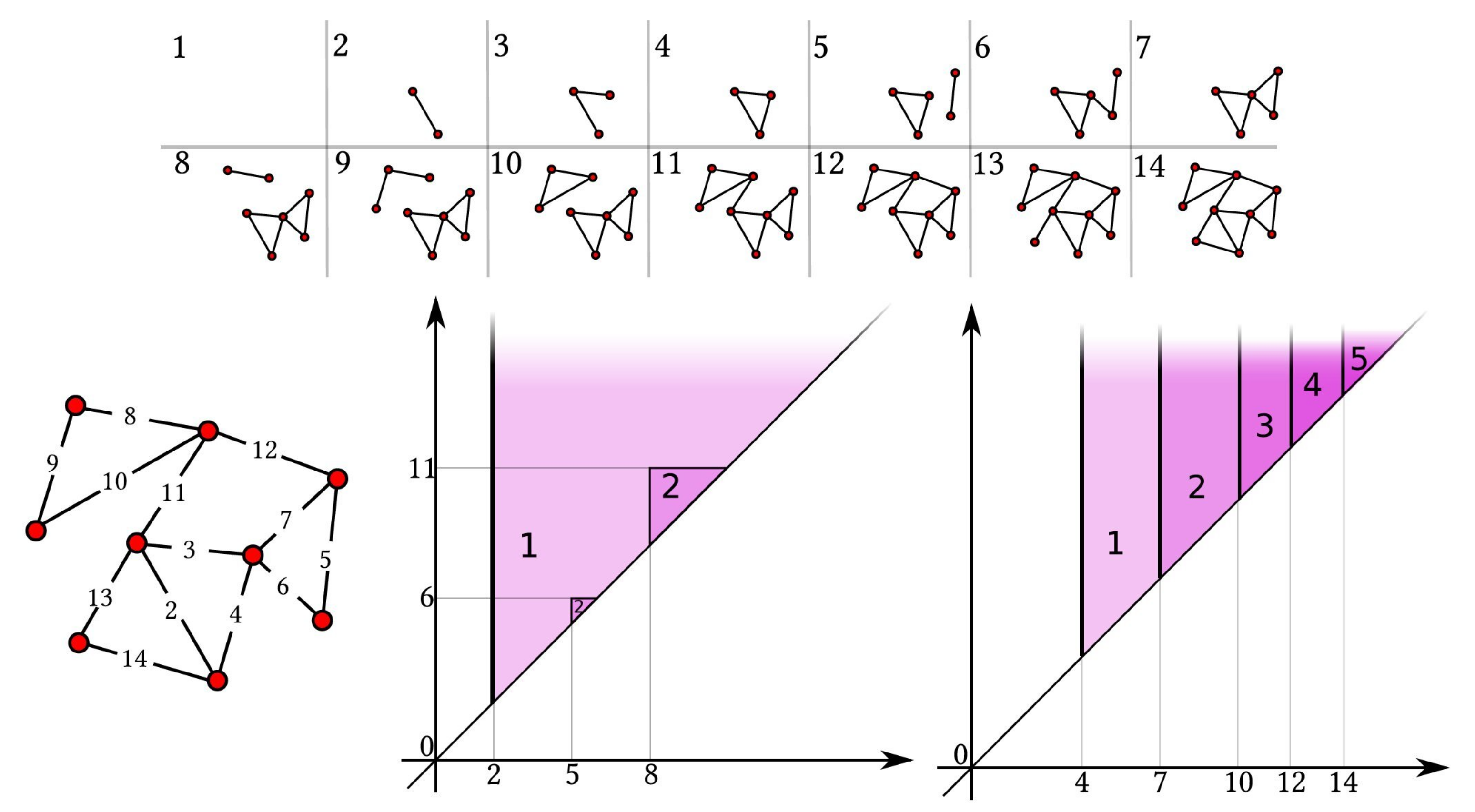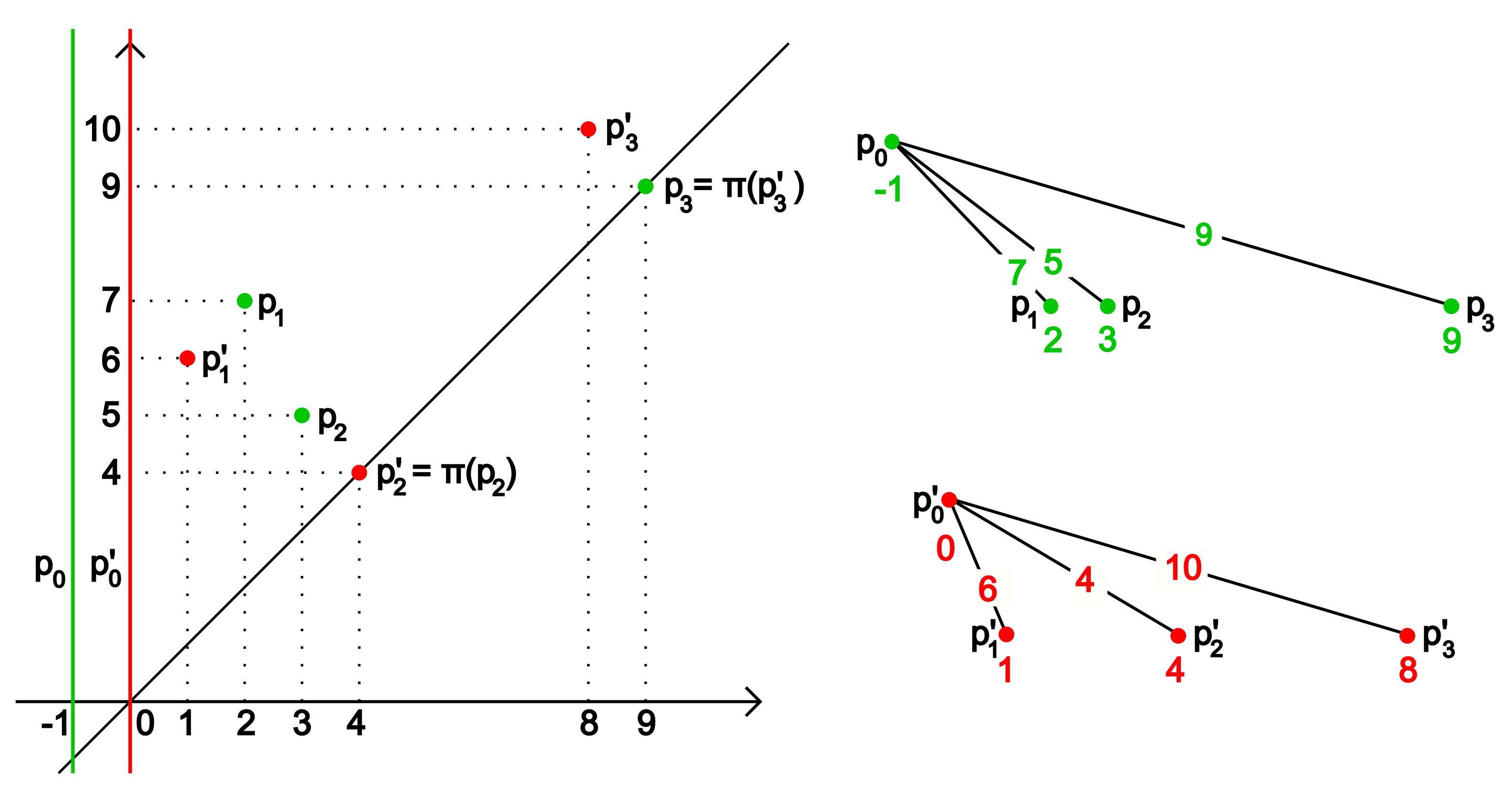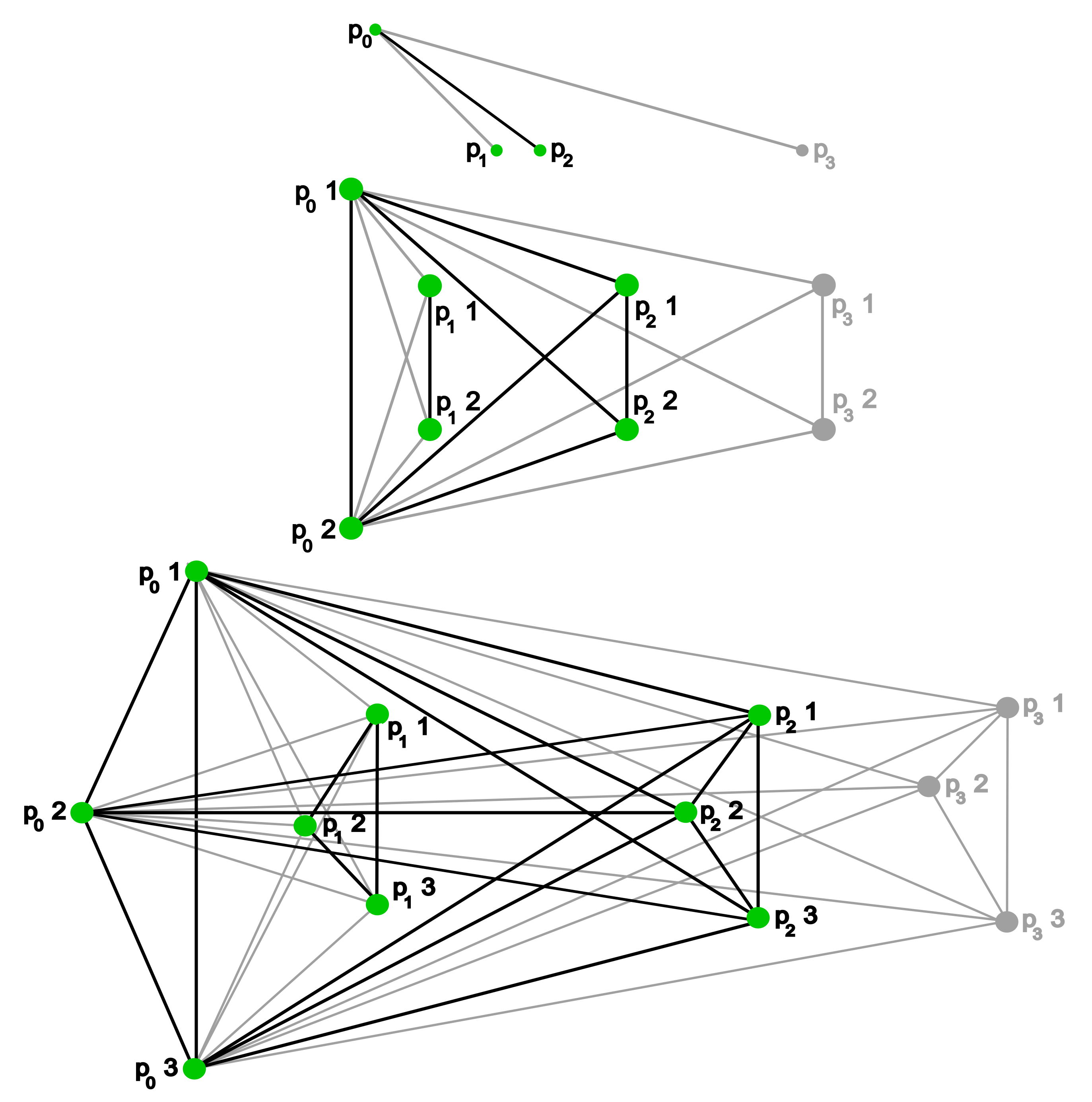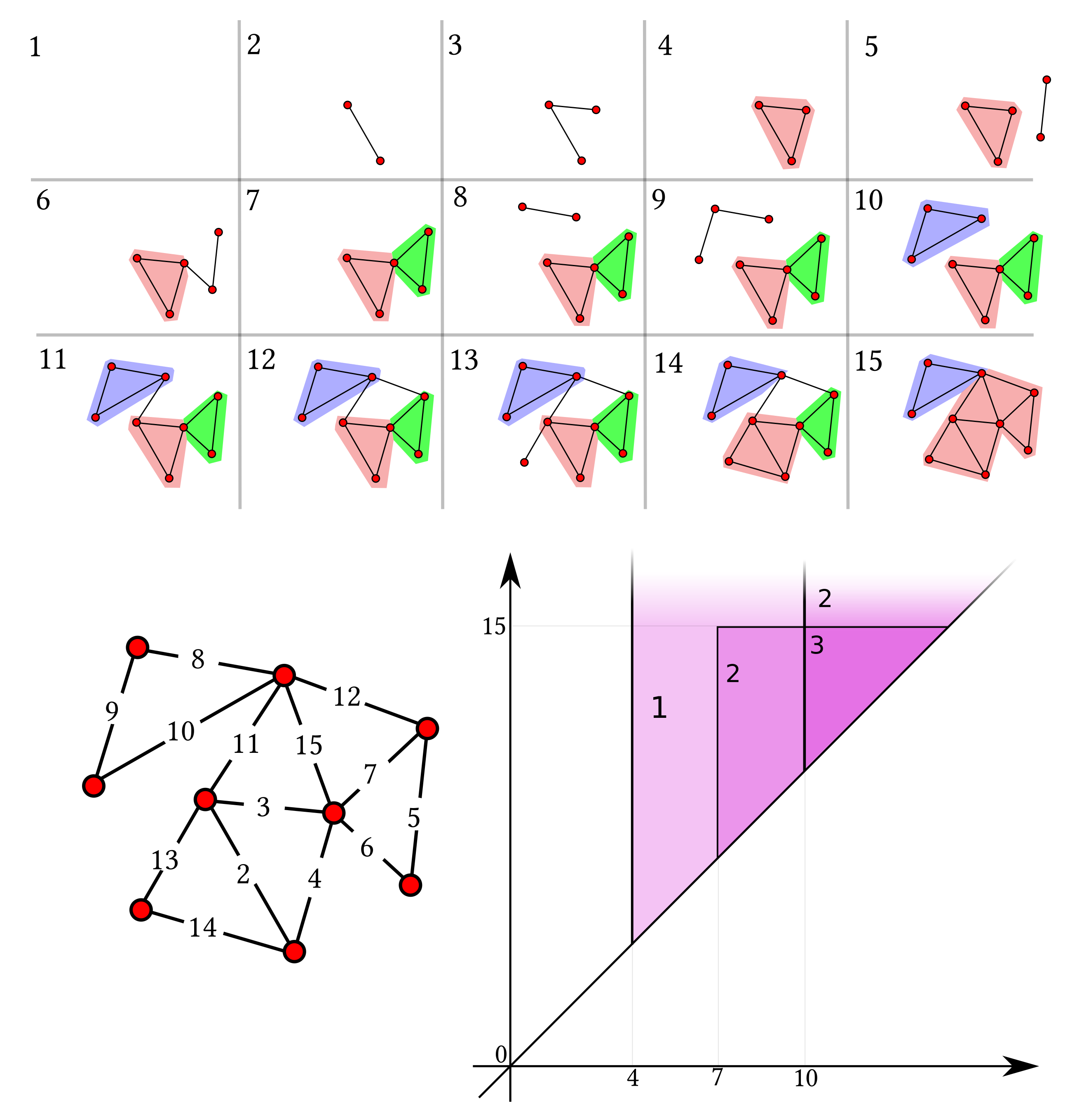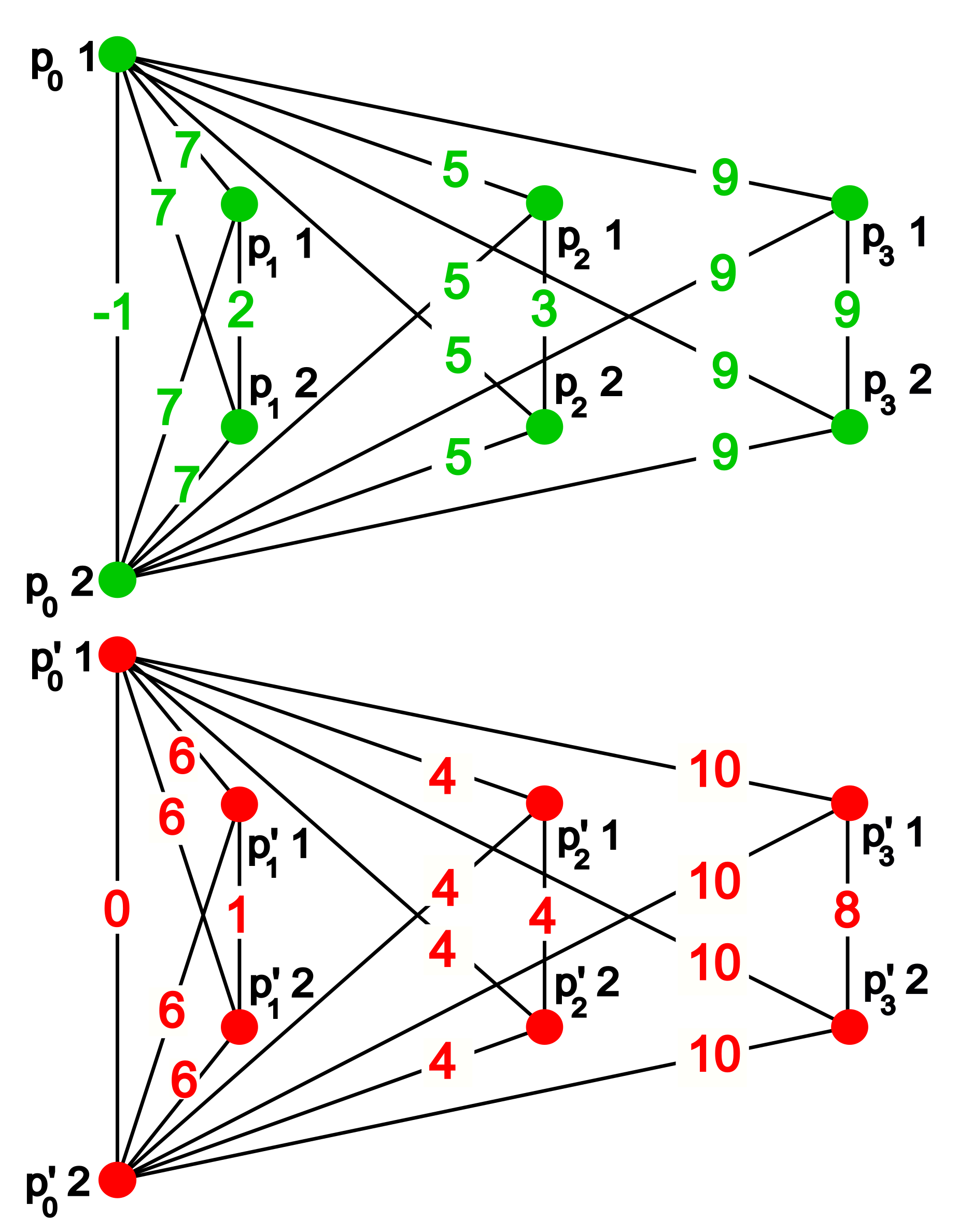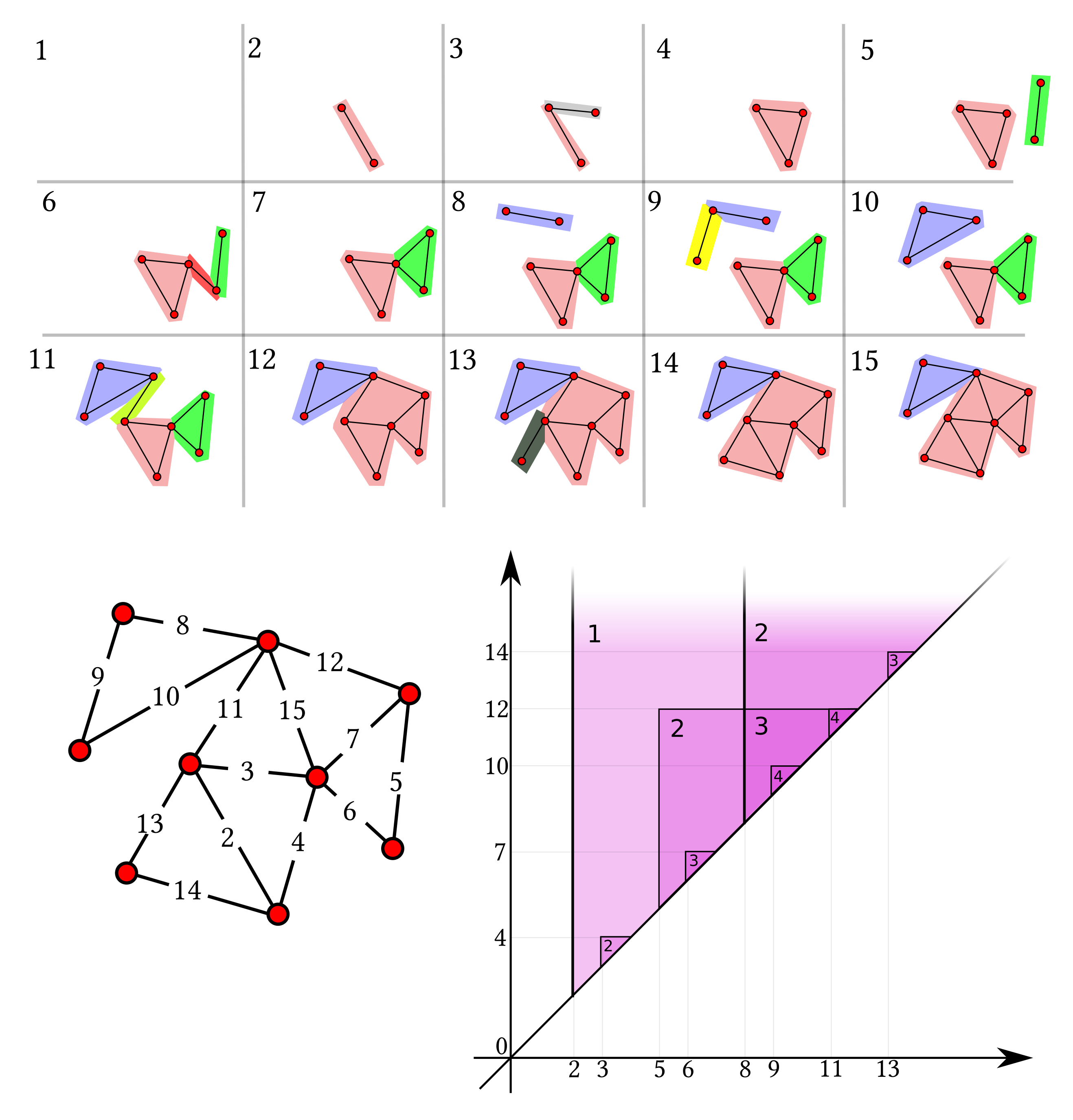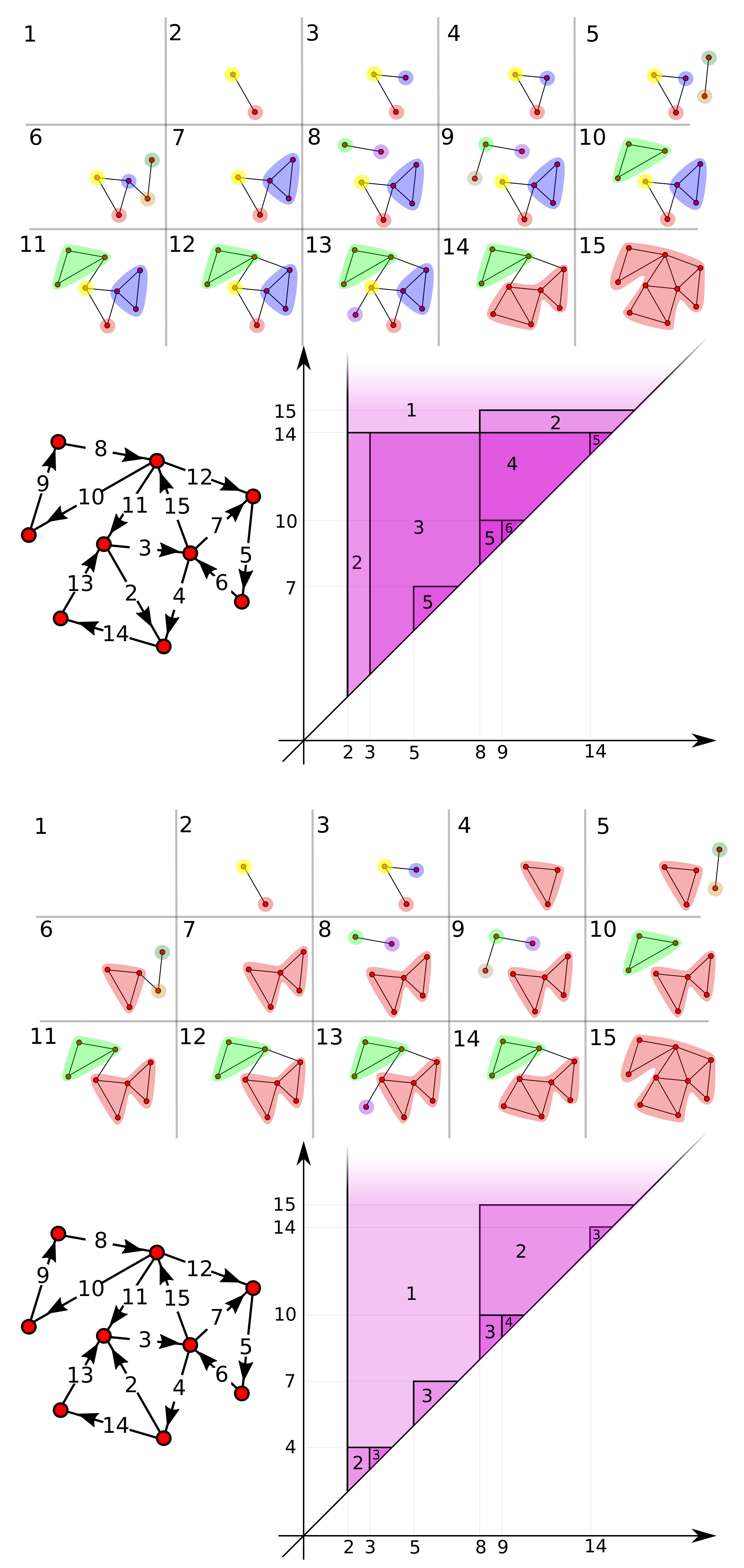1. Introduction
Persistent homology allows for swift and robust comparison of topological objects. However, raw data are rarely endowed with a topological structure. Persistent homology and topological persistence are by their nature bound to topological spaces and simplicial complexes, so that, in persistent homology applications, data are mapped to topological spaces or simplicial complexes through auxiliary constructions (e.g., [
1,
2,
3,
4,
5]). Although these constructions have been employed successfully in several domains (e.g., [
6,
7,
8,
9,
10]), they unavoidably transform the information carried by the original data set. Moreover, in some cases it is not possible to create such constructions directly, due to the lack of fundamental properties. For instance, the blocks of a filtered graph do not form a simplicial complex because blocks lack the hereditariness that is required by simplicial constructions. In particular, directed graphs generally present additional difficulties, although [
11] overcomes them elegantly, via a poset-based technique (an idea that we borrow and further develop in this work). Thus, it would be advantageous to be able to use the tools of persistence also if one is interested in graph-theoretical structures, which do not enjoy the hereditary property necessary for building simplicial complexes. This paper aims to promote this wider use of persistence in graphs.
Rank-based persistence [
12] extends topological persistence to arbitrary categories from an axiomatic perspective. In summary, the theory developed in [
12] allows one to compute the persistence of objects in arbitrary source categories (rather than topological spaces) and consider any regular category as the target category, whereas classical persistence is limited to vector spaces and sets.
We are well aware of greatly developed extensions of persistence beyond the topological or simplicial categories. [
13,
14,
15,
16,
17,
18] widely extend the range of target categories. In particular, by giving the possibility to use integer coefficients for homology (thus admitting torsion), these extensions can offer new perspectives to applications and theoretical developments. We are interested in extending the domain category, in the spirit of [
19]. We stick to the approach developed by [
12], which is axiomatic, consequently providing swift conditions to verify that a function is a persistence function. See
Section 2, in particular, Definition 1.
Our main aim is to build on the aforementioned categorical generalization to allow for more direct analysis of significant data types such as simple graphs and guarantee the properties of stability and universality of the classical persistence framework. We hope that the axiomatic foundation mentioned above will yield a tool agile enough to enable the usage of persistence in applications so far not liable to immediate, direct topological constructions (although a more elaborate one exists; see Remark 1).
With this aim in mind, we introduce the definition of
weakly directed properties as a way to easily build categorical persistence functions that describe graph-theoretical concepts of connectivity, e.g., clique communities,
k-vertex and
k-edge connectedness in graphs, and strong connectedness in digraphs. In more detail, in
Section 2, we define monic persistence functions and show how the persistence diagrams associated with such functions can be described as multisets of points and half-lines, as in the classical framework. Furthermore, we define the natural pseudodistance in this general context and list the assumptions necessary to obtain tame filters. In
Section 2.2, we introduce our framework in the category of weakly directed posets. We define stable monic persistence functions in this category and prove stability and universality. This construction allows us to define
weakly directed properties and describe the associated persistence functions.
In
Section 3 (possibly the one of main interest for the application-oriented reader), we show that clique communities,
k-vertex, and
k-edge connectedness in graphs, and strong connectedness in digraphs are weakly directed properties, and thus yield persistence functions, and persistence diagrams. Their stability and universality are discussed.
All constructions built through the proposed generalized persistence are discussed on the weighted graph depicted in
Figure 1. For completeness, in the same figure we compute persistent Betti numbers of the example graph, seen as a simplicial complex.
2. Persistence via the Poset of Subobjects
We give concrete applications of the framework developed in [
12], which defines the notion of
categorical persistence function ([
12], Def. 3.2) in arbitrary categories. Unlike [
12], here we restrict ourselves to filtrations, rather than arbitrary
-indexed diagrams. In other words, given a category
, we will consider categorical persistence functions in
, the subcategory of
where the only allowed morphisms are monomorphisms.
Definition 1 ([
12], Def. 3.2).
A persistence function
is a categorical persistence function on the category . It is a correspondence that maps each pair of real numbers , to an integer such that, given , the following inequalities hold. and , that is to say p is non-decreasing in the first argument, and non-increasing in the second.
.
Definition 2. Let be an arbitrary category. A monic persistence function on is a categorical persistence function on . It maps each inclusion to an integer , such that, given , the following inequalities hold.
and .
.
A filtration F in can naturally be seen as a functor from to . Therefore, by functoriality, a monic persistence function p on and a filtration F in induce a persistence function . In turn, induces a persistence diagram as follows. By convention, in the following definition we consider whenever either u or v is not finite.
Definition 3 ([
12], Def. 3.13).
Given , we define the multiplicity of , denoted , as the minimum of the following expression over disjoint connected neighborhoods of u and v respectively:Whenever , we say is a cornerpoint. The persistence diagram associated with is the multiset of its corner points, each with its multiplicity, along with all diagonal points , , with infinite multiplicity. A cornerpoint at infinity is often (and here) represented as the straight half-line .
It is then possible to extend to this setting the classical notion of bottleneck (formerly matching) distance.
Definition 4 ([
12], Def. 3.24).
Let p be a monic persistence function and be filtrations in ; let be the respective persistence diagrams. The bottleneck distance
between and is defined aswhere be the collection of all bijections from to . Importantly, the appearance of persistence diagrams as the familiar multiset of points and half-line segments is guaranteed by the following proposition, where are as above and .
Proposition 1. For and we havefor every which is no discontinuity point of . Proof. By applying ([
12], Prop. 3.17) with
and
. □
This result implies that the discontinuity sets of are either vertical or horizontal (possibly unbounded) segments with end-points in the corner points. This means that persistence functions have the appearance of superimposed triangles, typical of persistent Betti number functions.
Natural pseudodistance. It is possible to define the natural pseudodistance on . In the following, we will adopt some finiteness assumptions, to ensure stability of all persistence functions we will consider. Note that, whenever we refer to categories such as , we always refer to the finite version—finite sets, finite posets, and finite simple graphs and digraphs.
Finiteness assumptions. From now on, we assume that every object in
has only a finite number of distinct subobjects (to ensure tameness in all constructions). Furthermore, we will only consider filtrations
F that admit a colimit
in
. As every object has only a finite number of distinct subobjects, this means that
is an isomorphism for sufficiently large
. This will allow us to define the
natural pseudodistance [
13,
20,
21].
Definition 5. Let be two filtrations in . Let be the (possibly empty) set of isomorphisms between and . Given an isomorphism , we can consider the setwhere the inclusion is among subobjects of . The natural pseudodistance
between and is The natural pseudodistance is equal to the interleaving distance, when considering as -indexed diagrams in . By the universal property of colimits, a strong interleaving induces an isomorphism , which behaves correctly on sublevels. Conversely, applying and its inverse on sublevels induces a strong interleaving.
Stability and universality For applications, a wished-for quality is stability. A categorical persistence function
p on
is said to be
stable if, given filtrations
in
, for the induced
and the corresponding persistence diagrams
the inequality
holds. Moreover, the bottleneck distance is said to be
universal with respect to
p, if it yields the best possible lower bound for the natural pseudodistance, among the possible distances between
and
, for any
. See Proposition 5; see [
13] for a general discussion on universality.
2.1. Preliminaries on Posets
The first category we consider is , the category of finite weakly directed posets.
Definition 6. A poset P is weakly directed if, whenever have a lower bound, they also have an upper bound.
Stong [
22] discusses the analogy between finite posets and finite
topological spaces. The two categories are equivalent, and, therefore, it is possible to consider the homotopy type of a finite poset. In particular, Stong shows a procedure to determine whether two posets have the same homotopy type. For the sake of self-containment, we report here a description of the procedure from [
23].
Let P be a poset. An element is upbeat (resp. downbeat) if the set of all element strictly greater (resp. lower) than p has a minimum (resp. maximum). The insertion or deletion of an upbeat or downbeat point does not change the strong homotopy type of P. The core of P, denoted , is a deformation retract of P that is minimal; i.e., it contains neither upbeat nor downbeat elements. One can always reach by successively deleting beat points from P.
Theorem 1 ([
22], Thm. 4).
Two finite posets are strongly homotopy equivalent if and only if they have isomorphic cores. We are now ready to show that there is a canonical homotopy equivalence between weakly directed finite posets and finite sets.
Proposition 2. Let be the free poset functor, i.e., the functor that associates to a finite set S the weakly directed poset . admits a left adjoint M. Furthermore, let be the natural transformations associated to the adjunction. ϵ is a natural isomorphism, whereas η is a natural homotopy equivalence.
Proof. M associates each weakly directed poset to the set of its maximal elements. This mapping can be extended to a functor, as for each order-preserving map , given a maximal element , there is a unique maximal element with . Given a set S, the maximal elements of the poset are all elements of S, so is a natural isomorphism. For a weak-directed poset P, the map is a deformation retract of P onto its core. To see this, starting from P, we can proceed by removing elements that are maximal in . If an elements is maximal in , it is necessarily upbeat: distinct maximal elements in P can have no lower bound. After iteratively removing all elements in , we obtain the desired deformation retract . □
The functor
induces a monic persistence function on
, by ([
12], Prop. 3.6). Furthermore, such persistence function factors via a ranked category with finite colimits,
, and is therefore stable by ([
12], Thm. 3.27).
Universality is generally not granted for stable persistence functions. We now follow the logical line of Thm. 32 of [
21] for proving the universality of the bottleneck (or matching) distance among the lower bounds for the natural pseudodistance that can come from distances between persistent block diagrams.
Let F be a filtration in . If has several maximal elements, then all maximal elements arising in the filtration are bounded by one of them, so the construction can be performed for each of the lower set of maximal points of .
Proposition 3. Let be two filtrations in ; let , be the respective persistence diagrams. Then there exist filtrations such that
, ,
,
where d is the bottleneck distance between persistence diagrams. Therefore, d is universal with respect to the monic persistence function induced by M.
Proof. There is at least one bijection
between the multisets
and
which realizes the distance
. Let
and
be the multiplicities of the eldest cornerpoints at infinity of
, respectively, and
,
be the multiplicities of the remaining cornerpoints (possibly at infinity). We consider also cornerpoints on the diagonal, if they are needed to realize the matching distance. Up to relabeling the cornerpoints, we can assume that the matching is given by
for
. We denote
(resp.
) the coordinates of the cornerpoint
(resp.
). The distance
d is then the maximum of the distance in the
norm of corresponding points. We now construct new filtrations of posets
as follows. See
Figure 2 for a toy example.
Choosing the isomorphism
given by
, we can show that the pseudodistance between
H and
is smaller or equal than
d. By stability, it must be equal. □
2.2. Weakly Directed Properties
Some of the most informative graph-theoretical concepts describe the local connectivity of a graph from different viewpoints, e.g., considering the number of edges to be removed to disconnect it. The following definitions express these kinds of stronger connectivities that we will use as categorical persistence functions, e.g., connected and biconnected components.
Definition 7. By a property in a category we mean a class such that if an object X belongs to and object Y is -isomorphic to X, then also Y belongs to .To say that X has property means that .
Definition 8. Let be a category and let be a property. We call the functor that associates to each object in the poset of its subobjects that have property . We say that the property is weakly directed if, for all , is a weakly directed poset.
Proposition 4. Let be a category, and let be the subcategory of where the only allowed morphisms are monomorphisms. Let be a weakly directed property on . Then induces a stable categorical persistence function on , which we denote .
Proof. We can consider the functor
. As
is equipped with a persistence function, this induces a persistence function on
by ([
12], Prop. 3.3). □
Unlike stability, the universality of is in general not guaranteed. However, the following condition is sufficient to ensure it.
Proposition 5. Let be as in Definition 8 and Proposition 4. Let us further assume that there exists a functor such that is naturally isomorphic to M. That is to say, for all , the maximal elements of are in a one-to-one correspondence with the maximal elements of Q, and this bijection is natural in P. Then the bottleneck distance between persistence diagrams is universal with respect to .
Proof. Given two filtrations in , we can consider the filtrations of posets and . By Proposition 3, there are filtrations of weakly directed poset with the same persistence diagram, whose interleaving distance equals the bottleneck distance. Then, and have the same persistence diagram as , and their interleaving distance equals the bottleneck distance. □
3. Non-Simplicial Graph Persistence
In what follows, we fix and consequently is the subcategory of in which only graph monomorphisms are allowed. We now translate some of the previous notions in terms of graphs.
Definition 9. By a property we mean a set of graphs such that if a graph X belongs to and graph Y is isomorphic to X, then also Y belongs to . If , we say that X has property .
Definition 10. Let be a property. We call the functor that associates to each graph in the poset of its subgraphs that have property . We say that the property is weakly directed if, for all graphs X, is a weakly directed poset.
Remark 1. Topology is not really thrown out of the game. In fact, the nerve of the weakly directed poset is a simplicial complex. Let be the persistence diagram of an -indexed graph; it coincides with one of the persistence modules obtained by composing a chain of functors: Once more, we stress that our aim is to take the application-oriented researcher directly to the diagram, bypassing this detour.
Remark 2. The previous notions extend in a natural way to the case of , the category of directed graphs, discussed in Section 3.4. We now define a functor from to , which will turn useful in the next subsections.
Definition 11. Let n be a positive integer. Given a weakly directed poset Q, we can consider the graph whose vertices are , where distinct vertices and are connected by an edge if v and w are comparable in Q (see Figure 3 for an example of the constructions relative to the filtration H of Figure 2 and ). This mapping induces a functor . Remark 3. The functor will be used to prove the universality of the bottleneck distance, with respect to persistence functions obtained from clique communities, k-connectedness, k-edge-connectedness, and strong connectedness. For each of those, one could find specific functors that produce simpler graphs, i.e., with fewer edges. However, we prefer to show a unified construction that works in a wide variety of cases.
3.1. Clique Communities
An example of weakly directed property comes from clique communities. We recall the definition of clique community given in [
24]. Given a graph
, two of its
k-cliques (i.e., cliques of
k vertices) are said to be
adjacent if they share
vertices; a
clique community is a maximal union of
k-cliques such that any two of them are connected by a sequence of
k-cliques, where each
k-clique of the sequence is adjacent to the following one. This construction has been applied to network analysis [
25,
26,
27,
28] and to weighted graphs, in the classical topological persistence paradigm, in [
3]. Here we consider a weighted graph as a filtration of graphs (where the weight of each vertex is the inf of the weights of its incident edges).
Definition 12. A graph G belongs to if it is union of k-cliques, such that any two of them are connected by a sequence of adjacent k-cliques.
Proposition 6. is a weakly directed property.
Proof. If two subgraphs are in , and there is a k-clique in , then is also in . □
As a consequence, induces a stable persistence function on graph filtrations, which we call persistent k-clique community number. In practice, given a graph filtration F, the persistent k-clique community number equals the number of k-clique communities in that contain at least a k-clique when restricted to .
Remark 4. Of course, the persistent 2-clique community number function of a weighted graph , such that no isolated vertices appear in the filtration, coincides with its persistent 0-Betti number function.
An example of persistent 3-clique community number function can be seen in
Figure 4. We can associate to
, via ([
12], Def. 3.13), a
persistent k-clique community diagram.
Proposition 7. The bottleneck distance is universal with respect to .
Proof. Let be the functor introduced in Definition 11. Then is naturally isomorphic to M. By Proposition 5, the bottleneck distance is universal with respect to . □
Figure 5 shows the two weighted graphs which realize the natural pseudodistance equal to the bottleneck distance between the persistence diagrams of
Figure 2, when the persistence function is
. See the proof of Proposition 5 and the construction of Definition 11 for the underlying ideas.
3.2. Blocks
We recall that a connected graph is
k-vertex-connected if it has at least
k vertices and remains connected whenever fewer than
k vertices are removed [
29,
30]. We say that a maximal
k-vertex-connected subgraph of a given graph
G is a
k-vertex-connected component.
Let us denote be the class of k-vertex-connected graphs. Since it is closed under isomorphisms, it is a property.
Proposition 8. is a weakly directed property.
Proof. Let be k-vertex-connected subgraphs of a graph G, such that their intersection is k-vertex-connected. Let U be any set of vertices of with . Then the induced subgraphs are connected and the mutual intersections have at least one vertex. Since the union of connected graphs with nonempty intersection is connected, also is connected. Therefore, is k-vertex-connected. □
Property
induces a functor
and a stable monic persistence function
on graph filtrations, which we call
persistent k-block number. In practice, given a graph filtration
F, the persistent
k-block number
equals the number of
k-vertex-connected components in
that contain at least a
k-vertex-connected component when restricted to
.
Furthermore, the bottleneck distance is universal with respect to the natural pseudodistance. To prove universality, we consider the same functor of Definition 11, and note that is naturally isomorphic to M.
An example of
k-block number function (for
) can be seen in
Figure 6. We can then associate to
, via ([
12], Def. 3.13), a
persistent block diagram with all classical features granted by the propositions of
Section 2. A toy example is given in
Figure 6.
3.3. Edge-Blocks
We say that a connected graph is
k-edge-connected if it has at least
k edges and remains connected whenever fewer than
k edges are removed [
30]. We say that a maximal
k-edge-connected subgraph of a given graph
G is a
k-edge-connected component.
Let us denote be the class of k-edge-connected graphs. Since it is closed under isomorphisms, it is a property.
Proposition 9. is a weakly directed property.
Proof. Analogous to the proof of Proposition 8. □
Property
therefore it induces a functor
and a stable monic persistence function
on graph filtrations, which we call
persistent k-edge-block number. In practice, given a graph filtration
F, the persistent
k-edge-block number
equals the number of
k-edge-connected components in
that contain at least a
k-edge-connected component when restricted to
.
Furthermore, the bottleneck distance is universal with respect to the natural pseudodistance. To prove universality, we consider the same functor of Definition 11, and note that is naturally isomorphic to M.
An example of persistent edge-block number function (for
) can be seen in
Figure 7. We can associate to
, via ([
12], Def. 3.13), a
persistent edge-block diagram.
3.4. Strong Components in Digraphs
In this subsection,
, the category of directed graphs and homomorphisms;
is its subcategory where only monomorphisms are allowed. A directed graph is
strongly connected if for any pair of vertices
there is a directed path from
u to
v (and one from
v to
u) ([
31], Section 3.4). A
strong component of a digraph is a maximal strongly connected subdigraph.
We denote s the class of strongly connected digraphs. Since it is closed under isomorphisms, it is a property.
Proposition 10. s is a weakly directed property.
Proof. Immediate, since the strong components induce a partition of the vertex set. □
Hence, property
s induces a functor
and a stable monic persistence function
on digraph filtrations, which we call
persistent strong component number. In practice, given a digraph filtration
F, the persistent strong component number
equals the number of strong components in
that contain at least a strong component when restricted to
.
There exists a functor
, which replaces every undirected edge with a pair of directed edges with opposite orientations. The functor
(see Definition 11), for any
n, grants universality of the bottleneck distance.
Figure 8 shows the persistent strong component diagram on two orientations of the usual graph, differing only on the edge with weight 2.
4. Conclusions and Perspectives
We built on a generalized theory of persistence, which no longer requires topological mediations such as auxiliary simplicial constructions, or the usage of homology as the functor of choice.
We gave a flexible definition—weakly directed property—for the construction of generalized persistence functions, and we applied them to toy examples in the category of weighted graphs. Therein, we discussed the stability and universality of the generalized persistence functions built following our definitions and considering blocks, edge-blocks, and clique communities.
This work is the combinatorial counterpart of the foundational results exposed in [
12]. There, we focused on Abelian categories and categories of representations, aiming to extend the persistence to objects relevant in theoretical physics or theoretical chemistry: Lie-group representations, quiver representations, or representations of the category of cobordisms (related to topological quantum field theory in [
32]). Here, we focus on categories that generally do not have any additive structure, but are of interest in several branches of Machine Learning and Artificial Intelligence. Graphs, digraphs, and their connectivity properties occupy a central role in these research fields, where networks are oftentimes represented as weighted digraphs. These structures can be compared quantitatively via stable categorical persistence functions, and possibly optimized by defining bottleneck-distance-based loss functions. We hope that this work paves the road for new applications of the persistence paradigm in various fields.
Finally, the posets considered here are homotopically discrete by Proposition 2. Properties leading to non homotopically discrete posets—with nontrivial higher homology groups—might give rise to new graph invariants.
